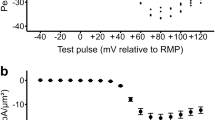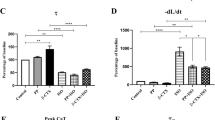Abstract
Various mechanisms have been proposed for β-adrenergically mediated relaxation of smooth muscle. All theories suggest the involvement of cyclic AMP as a second messenger: β-agonists stimulate adenylate cyclase which converts ATP to cyclic AMP1 and protein kinase, activated by cyclic AMP, is then thought to catalyse a protein phosphorylation that leads to a reduction in free Ca2+, thus effecting relaxation1. How this last step is accomplished is much debated, but the following possibilities are currently considered as the mechanisms responsible for cyclic AMP-induced reduction of cytoplasmic Ca2+: activation of a Ca2+-ATPase in the plasma and/or sarcoplasmic reticulum membranes which lowers cytoplasmic [Ca2+] in a direct manner or stimulation of (Na+–K+)ATPase in the cell membrane which may indirectly effect Ca2+ extrusion2–8. Among the hypotheses suggested, those of Ca2+ sequestration by the sarcoplasmic reticulum and of Ca2+ extrusion across the cell membrane are consistent with each other if it is assumed that both processes are effected by a cyclic AMP-sensitive Ca2+-ATPase. However, quite a different mechanism is implied by involving the Na+–K2+ pump and Na+–Ca2+ exchange carrier. In this report, we present evidence that suggests intracellular Ca2+ sequestration is the mechanism involved.
This is a preview of subscription content, access via your institution
Access options
Subscribe to this journal
Receive 51 print issues and online access
$199.00 per year
only $3.90 per issue
Buy this article
- Purchase on Springer Link
- Instant access to full article PDF
Prices may be subject to local taxes which are calculated during checkout
Similar content being viewed by others
References
Robison, G. A., Butcher, R. W. & Sutherland, E. W. Cyclic AMP, 197 (Academic, New York, 1971).
Kroeger, E. A., Marshall, J. M. & Bianchi, C. P. J. Pharmac. exp. Ther. 193, 309–316 (1975).
Bülbring, E. & den Hertog, A. J. Physiol., Lond. 268, 29P–30P (1977).
Nilsson, K. B. et al. in Excitation–Contraction Coupling in Smooth Muscle (eds Casteels, R., Godfraind, T. & Rüegg, J. C.) 187–197 (Elsevier, Amsterdam, 1977).
van Breemen, C. J. Physiol., Lond. 272, 317–329 (1977).
Somlyo, A. & Somlyo, A. V. Fedn Proc. 28, 1634–1648 (1969).
Scheid, C. R., Honeyman, T. W. & Fay, F. S. Nature 277, 32–36 (1979).
Reuter, H., Blaustein, M. P. & Haeusler, G. Phil. Trans. R. Soc. B265, 87–94 (1973).
Shimo, Y. & Holland, W. C. Am. J. Physiol. 211, 1299–1304 (1966).
van Breemen, C., Aaronson, P. & Loutzenhiser, P. Pharmac. Rev. 30, 167–208 (1979).
Deth, R. C. & van Breemen, C. Pflügers Arch. ges. Physiol. 348, 13–22 (1974).
Andersson, R., Lundholm, L., Mohne-Lundholme, E. & Nilsson, K. Adv. Cyclic Nucleotide Res. 1, 213–228 (1972).
Adelstein, R. S., Conti, M. A., Hathaway, D. R. & Klee, C. B. J. biol. Chem. 253, 8347–8350 (1978).
Author information
Authors and Affiliations
Rights and permissions
About this article
Cite this article
Mueller, E., van Breemen, C. Role of intracellular Ca2+ sequestration in β-adrenergic relaxation of a smooth muscle. Nature 281, 682–683 (1979). https://doi.org/10.1038/281682a0
Received:
Accepted:
Issue Date:
DOI: https://doi.org/10.1038/281682a0
This article is cited by
-
Involvement of Na+–Ca2+ exchanger in cAMP‐mediated relaxation in mice aorta: Evaluation using transgenic mice
British Journal of Pharmacology (2007)
-
Role of MMP-2 in PKCδ-mediated inhibition of Na+ dependent Ca2+ uptake in microsomes of pulmonary smooth muscle: Involvement of a pertussis toxin sensitive protein
Molecular and Cellular Biochemistry (2005)
-
Cyclic AMP‐mediated inhibition of gallbladder contractility: role of K+ channel activation and Ca2+ signaling
British Journal of Pharmacology (2004)
-
Theophylline attenuates Ca2+ sensitivity and modulates BK channels in porcine tracheal smooth muscle
British Journal of Pharmacology (2003)
-
Isoproterenol modulates the calcium channels through two different mechanisms in smooth-muscle cells from rabbit portal vein
Pfl�gers Archiv European Journal of Physiology (1994)
Comments
By submitting a comment you agree to abide by our Terms and Community Guidelines. If you find something abusive or that does not comply with our terms or guidelines please flag it as inappropriate.



